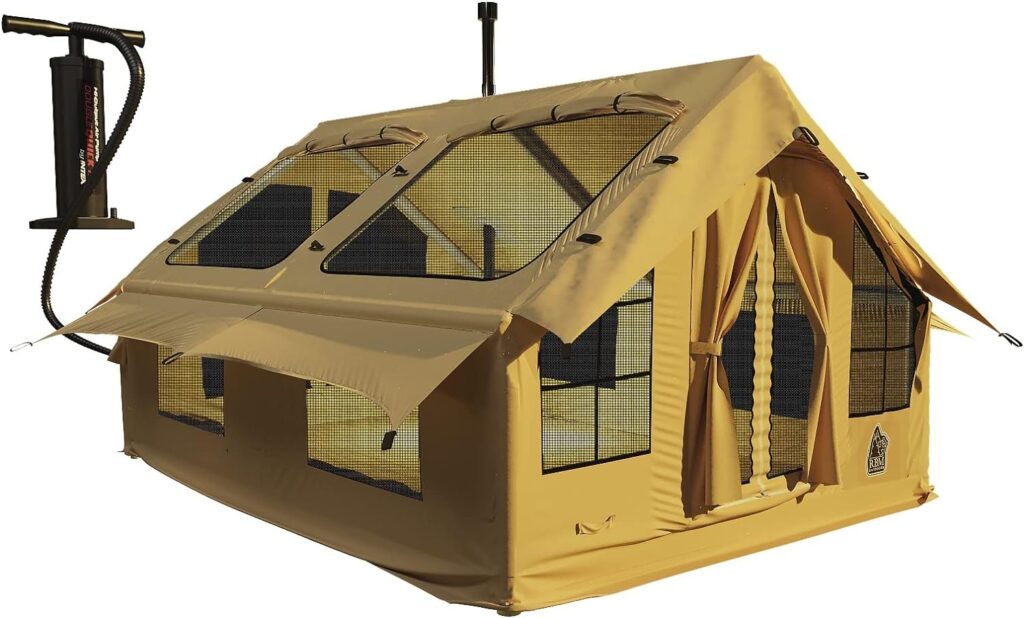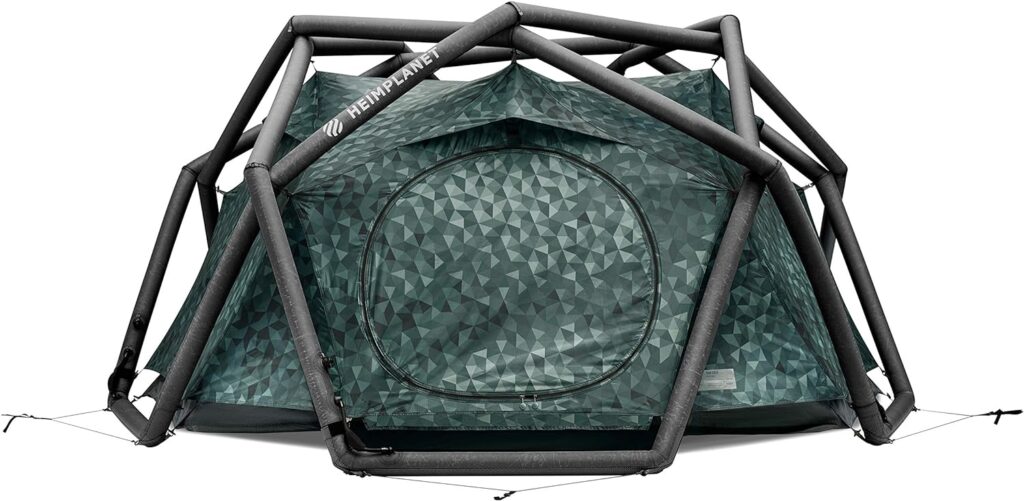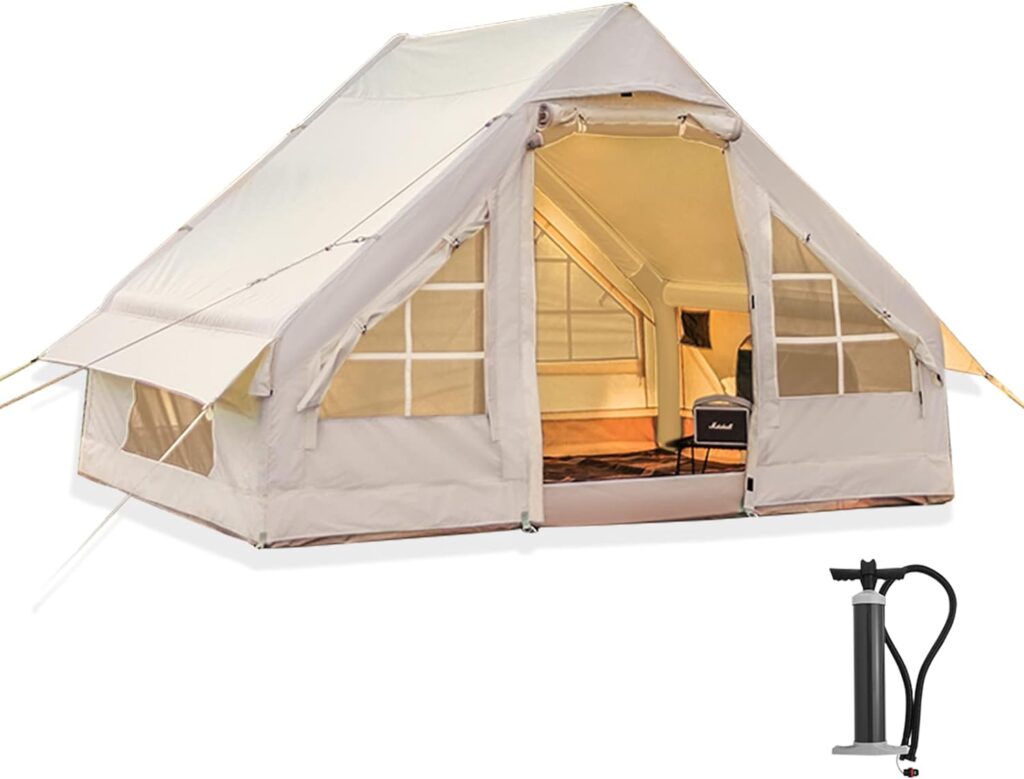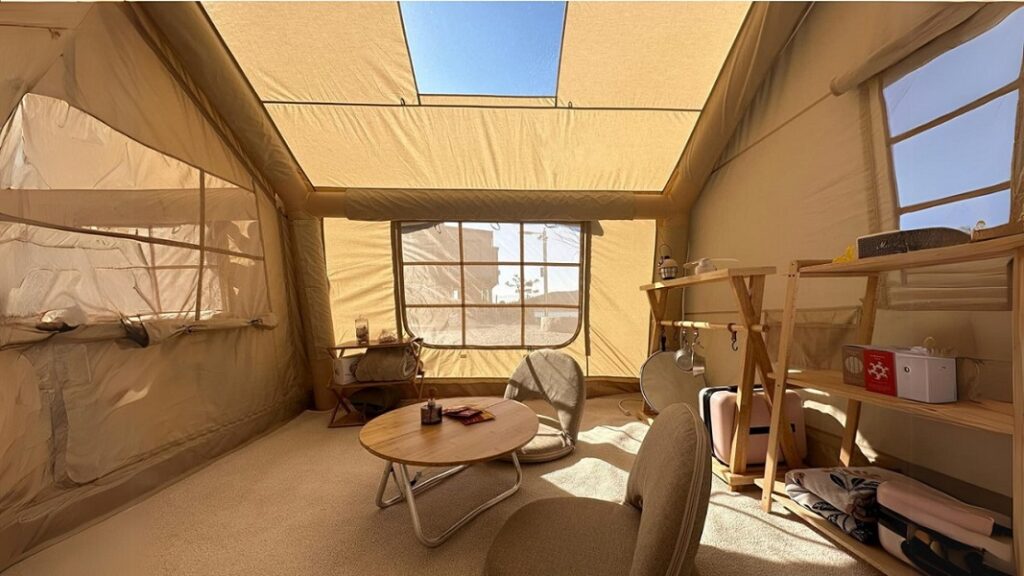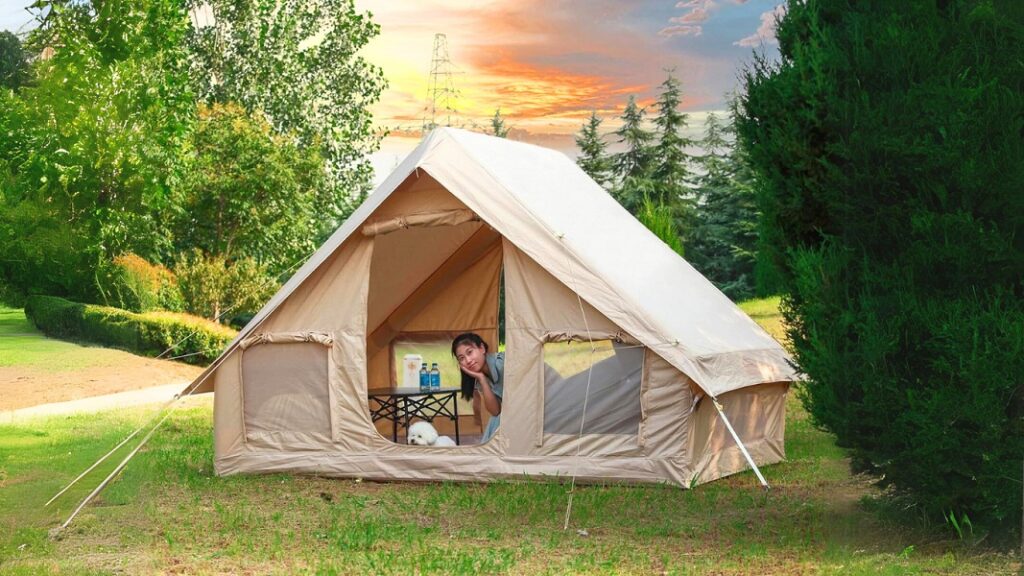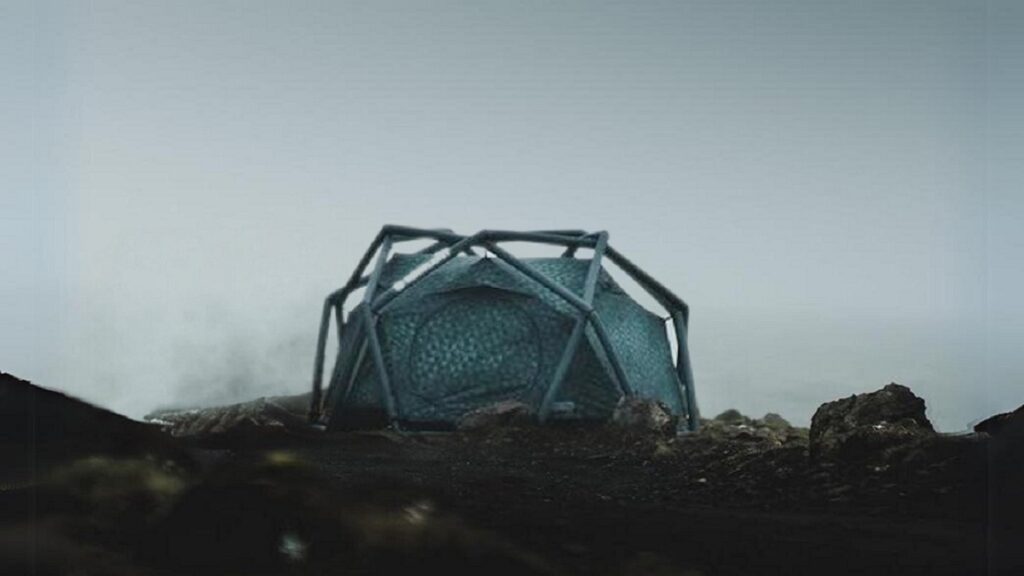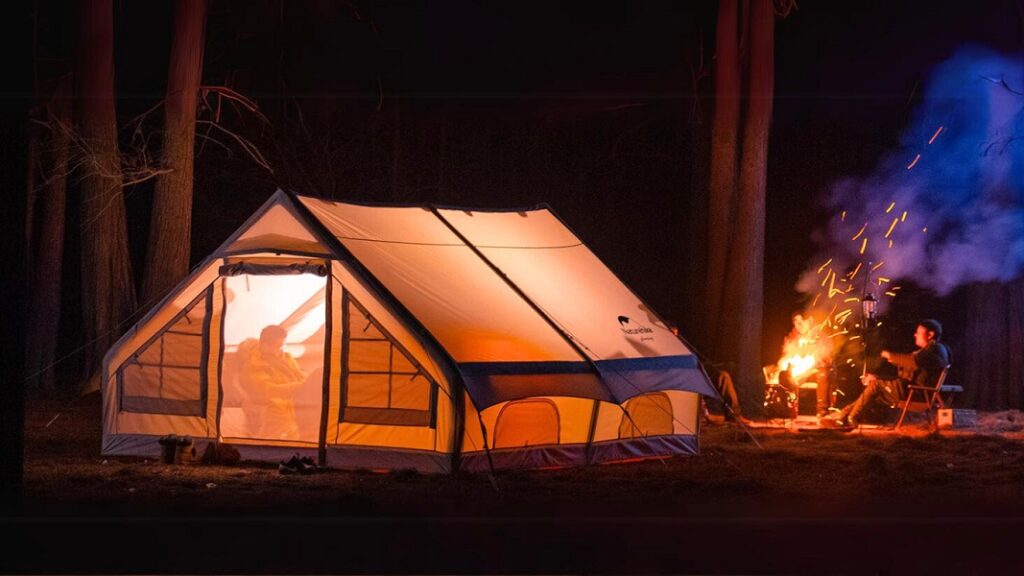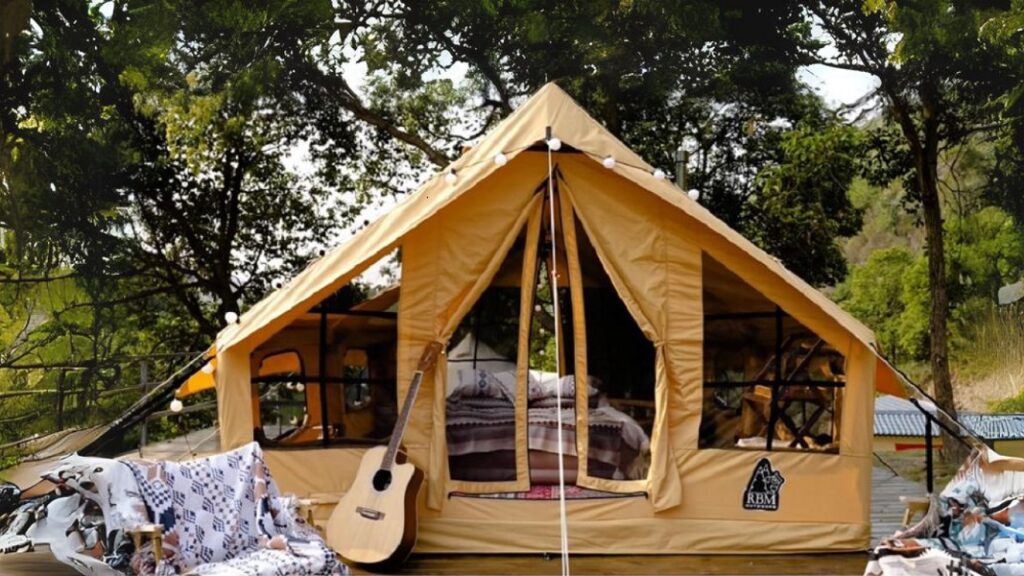The 5 Best Inflatable Tent – A Detailed Review

Remember the struggle of wrestling with tent poles, fumbling with instructions, and sweating under the summer sun just to get your shelter up? Well, inflatable tent are here to change the game! These innovative tents ditch the traditional poles altogether, relying on inflatable air beams to create a sturdy and comfortable shelter.
Imagine setting up your campsite in minutes! Simply inflate the air beams with a pump and watch your tent rise like magic. These tents are becoming increasingly popular for their ease of use, quick setup times, and spacious interiors. Whether you are a seasoned backpacker or a weekend camping enthusiast, these tents offer a convenient and comfortable way to experience the outdoors.
These handy units are more than just a place to wash your hands; they hold your sink, provide storage for toiletries, and set the overall style of your bathroom.
Wood vanities are becoming increasingly popular because they’re not only stylish but also practical. They can last for years with proper care, and their natural warmth creates a spa-like atmosphere.
Table of Contents
Here are the 5 Best Inflatable Camping Tent to Buy Online:
1. Panda Air: Spacious Glamping for 2-12 People
The Panda Air is a unique tent designed for comfortable for groups of 2-8 people. Here’s a breakdown of its features, pros, cons, and what customers are saying:
Key Features:
- Spacious: With enough room for 2-12 people and a tall ceiling, this tent offers a comfortable living area.
- Easy Setup: Ditch the poles! This tent inflates in minutes using an air pump (included).
- 4-Season Weatherproof: Made with durable canvas and featuring a waterproof design, this tent is suitable for year-round camping.
- Breathable: Two doors and multiple mosquito-net windows provide ventilation and keep bugs out.
- Stove Jack: A built-in stove jack allows for safe use of a camp stove for warmth and cooking.
- Panoramic Roof: Enjoy the view of the night sky with a large, see-through roof panel.
Pros:
- Quick and easy setup: Perfect for those who dislike wrestling with poles.
- Comfortable and spacious: Ideal for families or groups who want ample living space.
- Sturdy construction: The canvas material is built to withstand harsh weather conditions.
- Winter camping ready: The stove jack allows for heating the tent during colder months.
Cons:
- Relies on electricity: You’ll need a power source to inflate the tent with the pump.
- Bulkier than traditional tents: Deflated, the tent takes up more space than a pole tent.
- May be pricier: These camping tents tend to be more expensive than traditional ones.
What Customers Say:
Customers generally praise the Panda Air’s ease of use, spacious interior, and durability. Here are some common comments:
- “This tent was a lifesaver on our family camping trip! So much easier to set up than our old tent.”
- “We loved having all the space to relax and spread out. The stove jack was a game-changer for winter camping.”
- “A bit on the heavy side, but the comfort and convenience make it worth it.”
The Koala Air Tent offers a unique take on camping, bringing inflatable ease to a spacious 6-8 person tent. Here’s a closer look at its features, along with the good, the not-so-good, and what campers are saying:
Key Features:
- Spacious Interior: Fits 6-8 people comfortably with plenty of headroom thanks to its inflatable design.
- Quick Setup: Forget pole struggles! This tent inflates quickly with an included air pump.
- 4-Season Ready: Made with waterproof canvas, the Koala Air Tent tackles all kinds of weather.
- Breathable Design: Multiple mesh windows and doors offer ventilation and keep bugs at bay.
- Stove Jack: Enjoy safe camp stove usage for warmth and cooking with a built-in stove jack.
- Stargazing Roof: Unzip the roof panel and enjoy the night sky through a large, clear window.
Pros:
- Effortless Setup: Saves time and frustration compared to traditional pole tents.
- Spacious and Comfortable: Perfect for families or groups who want ample living area.
- Durable Construction: The canvas build promises to withstand different weather conditions.
- Winter Camping Friendly: The stove jack allows for heating the tent during colder seasons.
Cons:
- Needs Electricity: Requires a power source to inflate the tent with the pump.
- Bulkier Than Traditional Tents: When deflated, the tent takes up more space than a pole tent.
- Potentially Pricier: Inflatable air tents tend to be more expensive than their pole tent counterparts.
What Customers Say:
Campers generally love the Koala Air Tent’s ease of use, roomy interior, and sturdy build. Here are some common thoughts:
- “This tent was a breeze to set up on our camping trip! So much easier than our old tent with poles. Best inflatable tent for camping.”
- “Tons of space for everyone and our gear. The stove jack was perfect for keeping warm during the colder nights.”
- “Be aware of the size – it packs bigger than a regular tent. But the convenience makes up for it!”
The HEIMPLANET The Cave is a 2-3 person dometic inflatable tent designed for quick setup and comfortable camping. Here’s a breakdown of its features, advantages, disadvantages, and what campers are saying:
Key Features:
- Super Fast Setup: Inflates in seconds using a pump (not included) for a stress-free arrival at your campsite.
- Accommodates 2-3 People: Offers enough space for a small group or a couple with gear.
- Dome Design: Provides good headroom and a spacious feel.
- Waterproof Construction: With a 5,000mm water column rating, the tent keeps you dry in rainy weather.
- Durable Materials: Made with high-quality, weather-resistant materials built to last.
- Sustainable Choice: HEIMPLANET supports environmental causes by donating 1% to The Planet.
Pros:
- Lightning-Fast Pitching: Saves tons of time compared to traditional tents.
- Comfortable Interior: Enough space for sleeping and relaxing for a small group.
- Sturdy Build: High-quality materials ensure the tent can handle the elements.
- Great for Backpackers: Packs down relatively small for easier carrying on hikes.
Cons:
- Needs a Pump: Requires a separate pump (not included) for inflation.
- Limited Capacity: Best suited for 2-3 people, may feel cramped with more.
- Potentially Higher Price: These tents tend to be more expensive than some traditional options.
What Customers Say:
Campers generally love this inflatable dome tent’s incredibly fast setup, good quality, and compact size. Here are some common comments:
- “This tent is a lifesaver! Setting up camp after a long hike is a breeze now.”
- “Great for small groups or couples. Feels roomy and the quality seems excellent.”
- “Remember to get a pump separately! But overall, a fantastic tent.”
The XLTTYWL best Inflatable Camping Tent offers a luxurious take on camping, with inflatable ease and features for comfortable four-season use. Let’s explore its key features, the good and the not-so-good, and what campers are saying:
Key Features:
- Inflatable Design: Sets up in minutes with an included pump, ditching the hassle of poles.
- 4-Person Capacity: Offers comfortable sleeping space for 4 people and their gear.
- All-Weather Protection: Made with waterproof materials and designed to handle wind and rain.
- Breathable Comfort: Mesh windows and doors provide ventilation and keep bugs out.
- Luxury Cabin Style: Features a spacious interior with a tall ceiling for a more comfortable feel.
- Storage Pockets: Keep small items organized with convenient pockets inside the tent.
Pros:
- Super Easy Setup: Inflates quickly, saving time and frustration compared to traditional tents.
- Spacious and Comfortable: Ideal for families or small groups who want a roomy camping experience.
- Durable Construction: Promises to withstand different weather conditions.
- Great Ventilation: Mesh features allow for good airflow and prevent bugs.
Cons:
- Relies on Electricity: Requires a power source to inflate the tent with the pump.
- Bulkier Than Traditional Tents: When deflated, the tent takes up more space than a pole tent.
What Customers Are Saying:
Customer reviews for the XLTTYWL tent are generally positive, highlighting the ease of setup, spacious interior, and comfortable design. However, some mention the lack of weight information as a concern. Here are some common thoughts:
- “Love how fast and easy this tent is to set up! Perfect for quick camping trips.”
- “Plenty of space for our family and all our gear. The mesh windows are a big plus for ventilation.”
The Naturehike Tent offers a unique take on camping, bringing inflatable convenience to a spacious tent for 4-8 people. Here’s a breakdown of its features, the good, the not-so-good, and what campers are saying:
Key Features:
- Inflatable Design: Sets up quickly with a pump (included) for a hassle-free arrival at your campsite.
- Large Capacity: Provides ample sleeping space for 4-8 people, with room for gear.
- Four-Season Ready: Made with waterproof materials and designed to withstand wind and rain.
- Breathable Comfort: Double-layered mesh doors and windows offer ventilation and keep bugs out.
- Spacious Interior: Features a tall ceiling for a more comfortable and roomy feel.
- Expandable Options: Some versions come with an extension for even more space.
Pros:
- Effortless Setup: Saves time and frustration compared to traditional pole tents.
- Plenty of Space: Great for families, groups, or anyone who wants ample living space while camping.
- Durable Build: Promises to be weatherproof and handle different conditions.
- Good Ventilation: Mesh features allow for airflow and prevent bugs.
Cons:
- Needs Electricity: Requires a power source to inflate the tent with the pump.
- Bulkier Than Traditional Tents: Takes up more space when deflated compared to a pole tent.
- Weight Considerations: The tent can be heavy, so be mindful of transportation, especially for backpacking.
What Customers Say:
Campers generally love the Naturehike’s ease of setup, spacious interior, and comfortable design. However, some mention weight and potential bulk as considerations. Here are some common thoughts:
- This tent was a breeze to set up on our family camping trip! So much easier than our old tent.
- Tons of space for everyone and our gear. Great for group camping trips.
- Be aware of the size and weight – it’s not the most compact option. But the comfort makes up for it for car camping!
What is an Inflatable Tent ?
Imagine a tent that sets itself up! That’s the magic of best inflatable tents. Unlike traditional tents that rely on poles to hold their shape, these tents use air beams for structure. These air beams are basically long, hollow tubes made of durable, waterproof material. They run along the sides, roof, and sometimes even the floor of the tent.
When you’re ready to camp, you’ll use a pump to fill these air beams with air. As the air fills the tubes, they inflate and stiffen, creating the tent’s structure. It’s like blowing up a pool float, but for your entire camping shelter! This innovative design eliminates the need for fiddling with poles and lets you set up your tent in a fraction of the time.
Exploring the Various Types of Inflatable Tents
Camping industry has been revolutionized with the innovative designs and practical advantage of the inflatable house tents. As the demand for these tents continues to grow, manufacturers have introduced a wide range of models tailored to different camping preferences and requirements. Below is the various types of inflatable camping tents available in the market today, highlighting their unique features and applications.
1. Single Air Beam Tents
Single air beam tents are among the most basic and lightweight options available in the inflatable air tent category. These tents feature a single inflatable beam that serves as the main support structure. They are ideal for solo campers or minimalist backpackers looking for a compact and easy-to-pitch shelter. Despite their simplicity, single air beam tents offer sufficient space for one or two persons and are suitable for short-term camping trips.
2. Tunnel Tents
Tunnel tents, also known as hoop tents, are characterized by their enlarged shape and curved design. These tents typically have multiple inflatable beams arranged in a tunnel-like formation that provides ample headroom and interior space. Tunnel tents are popular among family campers and groups looking for a spacious and comfortable camping experience. They offer separate sleeping compartments and communal areas, that makes them ideal for extended camping trips.
3. Dome Tents
Inflatable dome tents are renowned for their stability and wind resistance, making them a popular choice for camping in challenging weather conditions. These tents feature a rounded, dome-shaped design supported by inflatable beams. These tents offer a good balance of interior space and compactness, making them suitable for both backpacking and car camping adventures. They are available in various sizes, from solo shelters to multi-person tents.
4. Pop-Up Tents
Pop-up tents are designed for ultimate convenience and rapid deployment. These tents feature an integrated inflatable frame that allows them to spring open and take shape automatically when unpacked. Pop-up tents are ideal for spontaneous camping trips or situations where quick setup is essential, such as festivals or events. While they may sacrifice some features found in traditional inflatable cabin tents, such as spaciousness and durability. Pop-up tents are best in terms of ease of use and portability.
5. Inflatable Tent Extensions
Inflatable house tent extensions, also known as awnings, are accessories that enhance the functionality of existing tents. These extensions can be attached to the main tent to provide additional living space, storage areas, or sheltered outdoor seating. They are also versatile additions to camping setups, allowing campers to customize their space according to their needs and preferences.
Why You Should Consider Buying an Inflatable Tent ?
In today’s market, camping enthusiasts are presented with a wide variety of tent options, each having unique features and benefits. These tents, utilize inflatable beams instead of traditional poles for support. This design revolutionizes the camping experience by simplifying setup and enhancing durability. Let’s explore the compelling reasons to invest in this modern camping essential.
1. Ease of Setup and Takedown
One of the primary advantages of inflatable air tents is their simple setup process. Unlike traditional tents that require complex pole assembly, these tents can be effortlessly pitched in a matter of minutes. This convenience is especially valuable when setting up camp in adverse weather conditions or during nightfall.
2. Enhanced Durability
These tents are made of tough materials designed to handle outdoor wear and tears. The inflatable beams, typically made from durable fabrics such as TPU or PVC, offer excellent strength and resilience against wind, rain, and other environmental factors. This durability ensures that your investment in an inflatable house tent pays off over the long term.
3. Compact and Lightweight Design
Despite their robust construction, these tents are surprisingly lightweight and compact when packed away. This makes them ideal for campers who prioritize portability and efficiency. Whether you’re embarking on a backpacking excursion or setting up base camp for a family vacation, these tents offer the perfect balance of durability and convenience.
4. Versatility in Terrain
Inflatable camping tents excel in various terrain conditions, including rocky surfaces and uneven ground. The flexibility of inflatable beams allows the tent to adapt to the surface and environment, ensuring a stable and secure shelter wherever you choose to pitch it. This versatility expands your camping possibilities, allows you to explore remote and challenging environments with confidence.
5. Family-Friendly Features
For families, these tents offer practical advantages that simplify the camping experience. Many models feature spacious interiors with multiple rooms, providing ample space for sleeping and storage. Additionally, the inflatable design eliminates the risk of accidental injuries from traditional tent poles, making it safer for children to roam freely inside the tent.
Factors to Consider When Choosing an best Inflatable Tent
Inflatable air tents have become increasingly popular for their ease of setup and spacious interiors. However, with various models and features available, choosing the right one for your needs can be overwhelming. Here’s a breakdown of key factors to consider before you hit “add to cart”:
1. Capacity and Comfort
- Number of People: These tents come in a range of sizes, accommodating 2-8 people comfortably. Consider the number of campers and the amount of gear you’ll need to store inside.
- Interior Space: Look for the tent’s floor area and ceiling height. Tall ceilings create a more open feel, while adequate floor space ensures everyone can move around comfortably. Some tents even have separate sleeping compartments for added privacy.
- Features for Comfort: Think about mesh windows and doors for ventilation, especially in warmer climates. A built-in awning can provide shade or shelter from light rain. Some tents even have stove jacks for safe use of a camp stove for warmth and cooking.
2. Weatherproofing
- Seasonality: These tents come in 3-season and 4-season options. 3-season tents are ideal for spring, summer, and fall camping in moderate weather conditions. 4-season tents are sturdier and built for harsher conditions with wind, rain, and potentially snow.
- Waterproofing: Check the tent’s water resistance rating, measured in millimeters (mm). A higher rating indicates better protection from rain. Aim for a minimum of 3,000mm for moderate rain and upwards of 5,000mm for heavier downpours.
- Wind Resistance: Look for a tent with a strong frame design and good quality anchoring points. Consider the wind conditions at your typical camping locations.
3. Setup and Portability
- Ease of Inflation: Most inflatable tent house come with a pump (manual or electric) for quick setup. Pay attention to the number of inflation points and how long it takes to inflate the tent fully.
- Portability: While these tents are generally lighter than traditional pole tents, they tend to be bulkier when deflated. Consider the storage space in your car and how easy it will be to transport the tent, especially if you plan on backpacking.
- Weight: For car camping, weight might not be a major concern. However, for backpackers, every ounce counts. Check the tent’s weight and see if it fits your backpacking limitations.
4. Additional Considerations
- Budget: It generally costs more than traditional pole tents. Set a budget and compare features within your price range.
- Durability: Look for a tent made with high-quality, weather-resistant materials. Double stitching on seams and reinforced corners will ensure a longer lifespan for your tent.
- Brand Reputation: Research different brands and read customer reviews to get a sense of the quality and reliability of the tents.
Inflatable Tent - Care and Maintenance Tips
Just like any piece of outdoor gear, proper care will extend the lifespan of your inflatable tent house and ensure a smooth camping experience. Here are some key tips to keep your inflatable friend happy:
1. Cleaning:
- After each use, give your tent a good wipe down with a damp cloth and gentle soap to remove dirt and debris. Avoid harsh chemicals or abrasive cleaners that could damage the material.
- If you encounter tougher stains, spot clean them with a mild solution of water and baking soda. Always rinse thoroughly with clean water and allow the tent to dry completely before storing it.
2. Drying
- Never store your tent wet! Moisture can lead to mold and mildew growth, which can damage the fabric and make your tent smell funky. After cleaning or a camping trip, make sure the tent is completely dry before packing it away. Open it up indoors or in a shaded area with good air circulation to speed up drying.
3. Storage:
- When storing your tent, deflate it completely and fold it loosely. Don’t pack it away tightly, as this can put unnecessary stress on the seams.
- Store your tent in a cool, dry place out of direct sunlight. Avoid attics, garages, or basements that can get hot or humid.
- If possible, keep your tent in its original storage bag or a breathable container.
4. Deflation and Inflation:
- When deflating your tent, release the air slowly and carefully. Don’t force the air out, as this could damage the valves.
- When inflating the tent, follow the manufacturer’s instructions and avoid over-inflation. Overfilling the air beams can put stress on the seams and potentially cause leaks.
5. Repairs:
- Small punctures can happen. Luckily, most these tents come with repair kits that allow you to patch up minor leaks.
- If you encounter a larger tear or damage, it’s best to consult the manufacturer or a professional repair service.
Bonus Tip
Invest in a footprint (ground tarp) to place under your tent. This will protect the tent’s underside from sharp objects and ground wear, further extending its lifespan.
By following these simple care and maintenance tips, you can ensure your tent remains a reliable and comfortable companion for all your outdoor adventures.
Steps for Setting Up and Taking Down Your Inflatable Tent
Inflatable house tents are all about convenience, and that extends to setting them up and taking them down. Here’s a quick guide to get you started:
Setting Up:
- Find a Level Site: Choose a flat, clear area free of rocks, sticks, or other sharp objects that could puncture the tent floor.
- Unpack and Layout: Spread the tent out flat, ensuring all doors and windows are unzipped. Locate the air valves, usually found on the sides or ends of the inflatable beams.
- Inflation Time: Attach the pump (usually included) to the valves and inflate each air beam according to the manufacturer’s instructions. Don’t overinflate! Most tents have pressure gauges or markings to indicate the proper inflation level.
- Stake it Down: Once inflated, secure the tent to the ground using the provided stakes and guy lines. Start by staking down the corners and then work your way around the perimeter, ensuring the tent is taut and stable.
- Finishing Touches: Depending on your tent, you might have additional steps like attaching the rainfly or awning. Refer to the manufacturer’s instructions for any specific features.
Taking Down:
- Deflation: Open all the air valves and allow the air to escape slowly. You can gently press on the air beams to help push out the remaining air.
- Unstake and Unzip: Loosen the guy lines and stakes, then unzip the doors and windows.
- Folding Up: Once deflated, loosely fold the tent inward towards the center. Start from one side and fold it repeatedly until it becomes a manageable size.
- Packing Away: Roll the folded tent tightly, starting from the opposite end of the air valves. This helps squeeze out any remaining air. Secure the rolled tent with the straps or stuff sack provided.
Conclusion
Inflatable tents offer a unique blend of convenience, durability, and weather resistance, making them a compelling choice for campers and outdoor enthusiasts. With the variety of options available, careful consideration of the factors we discussed will ensure you find the perfect tent for your needs. Remember, proper maintenance will extend the lifespan of your tent, and knowing how to inflate and deflate it efficiently will save you precious time on your adventures. So ditch the poles, embrace the air, and get ready to experience the ease and enjoyment of inflatable tent camping!
